NVIDIA Tegra X1 Preview & Architecture Analysis
by Joshua Ho & Ryan Smith on January 5, 2015 1:00 AM EST- Posted in
- SoCs
- Arm
- Project Denver
- Mobile
- 20nm
- GPUs
- Tablets
- NVIDIA
- Cortex A57
- Tegra X1
Automotive: DRIVE CX and DRIVE PX
While NVIDIA has been a GPU company throughout the entire history of the company, they will be the first to tell you that they know they can’t remain strictly a GPU company forever, and that they must diversify themselves if they are to survive over the long run. The result of this need has been a focus by NVIDIA over the last half-decade or so on offering a wider range of hardware and even software. Tegra SoCs in turn have been a big part of that plan so far, but NVIDIA of recent years has become increasingly discontent as a pure hardware provider, leading to the company branching out in unusual ways and not just focusing on selling hardware, but selling buyers on whole solutions or experiences. GRID, Gameworks, and NVIDIA’s Visual Computing Appliances have all be part of this branching out process.
Meanwhile with unabashed car enthusiast Jen-Hsun Huang at the helm of NVIDIA, it’s slightly less than coincidental that the company has also been branching out in to automotive technology as well. Though still an early field for NVIDIA, the company’s Tegra sales for automotive purposes have otherwise been a bright spot in the larger struggles Tegra has faced. And now amidst the backdrop of CES 2015 the company is taking their next step into automotive technology by expanding beyond just selling Tegras to automobile manufacturers, and into selling manufacturers complete automotive solutions. To this end, NVIDIA is announcing two new automotive platforms, NVIDIA DRIVE CX and DRIVE PX.
DRIVE CX is NVIDIA’s in-car computing platform, which is designed to power in-car entertainment, navigation, and instrument clusters. While it may seem a bit odd to use a mobile SoC for such an application, Tesla Motors has shown that this is more than viable.
With NVIDIA’s DRIVE CX, automotive OEMs have a Tegra X1 in a board that provides support for Bluetooth, modems, audio systems, cameras, and other interfaces needed to integrate such an SoC into a car. This makes it possible to drive up to 16.6MP of display resolution, which would be around two 4K displays or eight 1080p displays. However, each DRIVE CX module can only drive three displays. In press photos, it appears that this platform also has a fan which is likely necessary to enable Tegra X1 to run continuously at maximum performance without throttling.
NVIDIA showed off some examples of where DRIVE CX would improve over existing car computing systems in the form of advanced 3D rendering for navigation to better convey information, and 3D instrument clusters which are said to better match cars with premium design. Although the latter is a bit gimmicky, it does seem like DRIVE CX has a strong selling point in the form of providing an in-car computing platform with a large amount of compute while driving down the time and cost spent developing such a platform.
While DRIVE CX seems to be a logical application of a mobile SoC, DRIVE PX puts mobile SoCs in car autopilot applications. To do this, the DRIVE PX platform uses two Tegra X1 SoCs to support up to twelve cameras with aggregate bandwidth of 1300 megapixels per second. This means that it’s possible to have all twelve cameras capturing 1080p video at around 60 FPS or 720p video at 120 FPS. NVIDIA has also made most of the software stack needed for autopilot applications already, so there would be comparatively much less time and cost needed to implement features such as surround vision, auto-valet parking, and advanced driver assistance.
In the case of surround vision, DRIVE PX is said to deliver a better experience by improving stitching of video to reduce visual artifacts and compensate for varying lighting conditions.
The valet parking feature seems to build upon this surround vision system, as it uses cameras to build a 3D representation of the parking lot along with feature detection to drive through a garage looking for a valid parking spot (no handicap logo, parking lines present, etc) and then autonomously parks the car once a valid spot is found.
NVIDIA has also developed an auto-valet simulator system with five GTX 980 GPUs to make it possible for OEMs to rapidly develop self-parking algorithms.
The final feature of DRIVE PX, advanced driver assistance, is possibly the most computationally intensive out of all three of the previously discussed features. In order to deliver a truly useful driver assistance system, NVIDIA has leveraged neural network technologies which allow for object recognition with extremely high accuracy.
While we won’t dive into deep detail on how such neural networks work, in essence a neural network is composed of perceptrons, which are analogous to neurons. These perceptrons receive various inputs, then given certain stimulus levels for each input the perceptron returns a Boolean (true or false). By combining perceptrons to form a network, it becomes possible to teach a neural network to recognize objects in a useful manner. It’s also important to note that such neural networks are easily parallelized, which means that GPU performance can dramatically improve performance of such neural networks. For example, DRIVE PX would be able to detect if a traffic light is red, whether there is an ambulance with sirens on or off, whether a pedestrian is distracted or aware of traffic, and the content of various road signs. Such neural networks would also be able to detect such objects even if they are occluded by other objects, or if there are differing light conditions or viewpoints.
While honing such a system would take millions of test images to reach high accuracy levels, NVIDIA is leveraging Tesla in the cloud for training neural networks that are then loaded into DRIVE PX instead of local training. In addition, failed identifications are logged and uploaded to the cloud in order to further improve the neural network. Both of these updates can be done either over the air or at service time, which should mean that driver assistance will improve with time. It isn’t a far leap to see how such technology could also be leveraged in self-driving cars as well.
Overall, NVIDIA seems to be planning for the DRIVE platforms to be ready next quarter, and production systems to be ready for 2016. This should mean that it's possible for vehicles launching in 2016 to have some sort of DRIVE system present, although it's possible that it would take until 2017 to see this happen.



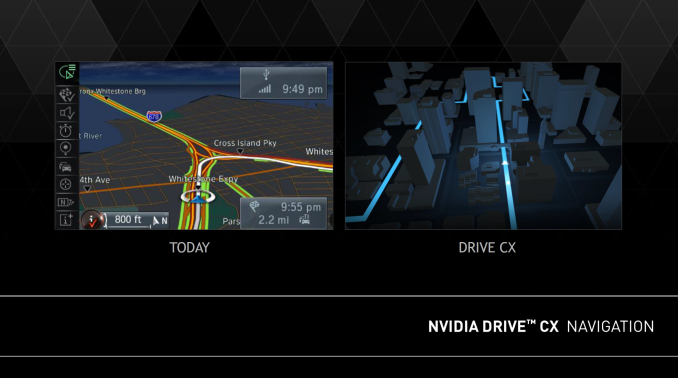
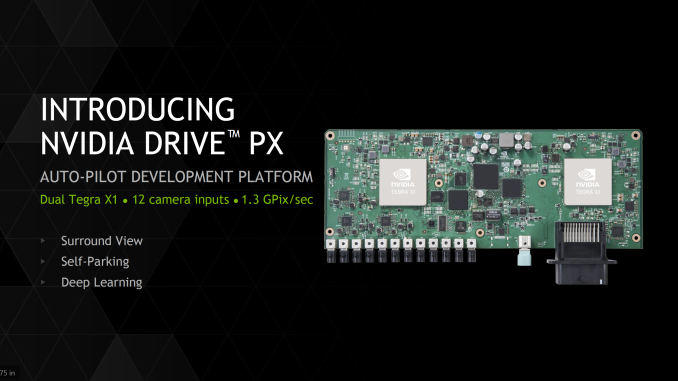
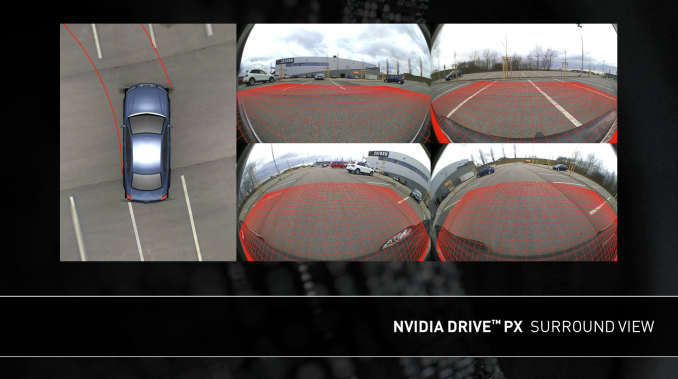

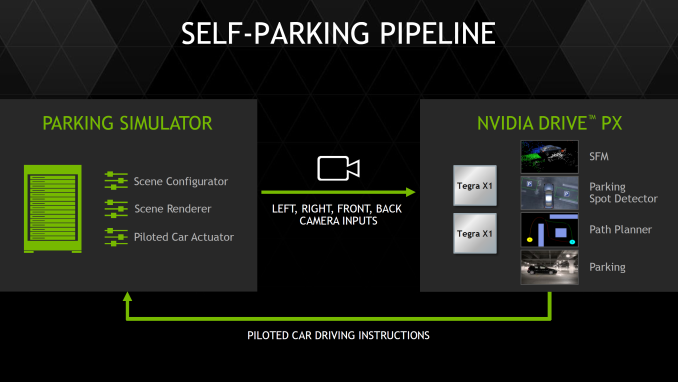


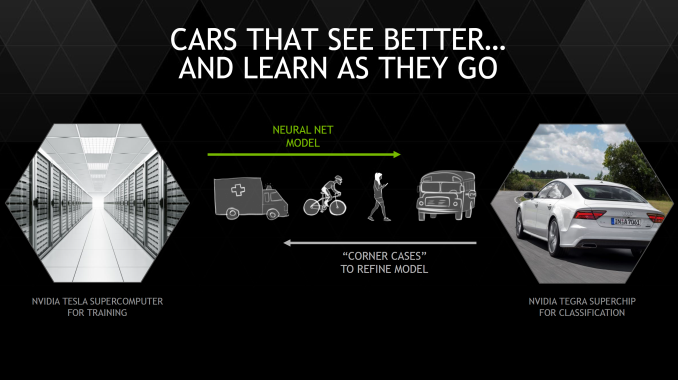
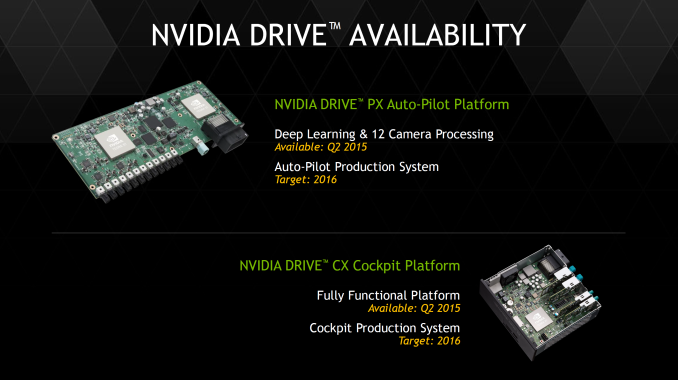








194 Comments
View All Comments
juicytuna - Monday, January 5, 2015 - link
Well said. Apple's advantage is parallel development and time to market. Their GPU architecture is not that much *better* than their competitors. In fact I'd say that Nvidia has had a significant advantage when it comes to feature set and performance per watt on a given process node since the K1.GC2:CS - Monday, January 5, 2015 - link
Maybe an adventage in feature set, but performance per watt ?So if you want to compare than For example xiaomi miPad, consumes around 7,9W, when running gfx bench battery life test and that is with performance throttled down to around 30,4 fps on screen a very similar tablet, the iPad mini with retina display and it's A7 processor (actually a 28nm part !) consumes just 4,3W and that is running at 22,9 fps for the whole time.
So I am asking where is that "class leading" efficiency and "significant adventage when it comes to performace per watt" that nvidia is claiming to achieve, because I actually don't see anything like that.
Yojimbo - Monday, January 5, 2015 - link
Looking at the gfxbench website, under "long-term performance" I see 21.4 fps listed for the iPad Mini Retina and 30.4 fps listed for the Mi Pad, maybe this is what you are talking about. That is a roughly 40% advantage in performance for the Mi Pad. I can't find anything that says about throttling or the number of Watts being drawn during this test. What I do see is another category listed immediately below that says "battery lifetime" where the iPad Mini Retina is listed at 303 minutes and the Mi Pad is listed at 193 minutes. The iPad Mini Retina has a 23.8 watt-hour battery and the Mi Pad has a 24.7 watt-hour battery. So this seems to imply that the iPad Mini Retina is drawing about 4.7 watts and the Mi Pad is drawing about 7.7 watts, and it comes out to the Mi Pad using about a 63% more power. 40% more performance for 63% more power is a much closer race than the numbers you quoted (Yours come out to about a 33% increase in performance and an 84% increase in power consumption, which is very different.), and one must remember the circumstances of the comparison. Firstly, it is a comparison at different performance levels (this part is fair, since juicytuna claimed that NVIDIA has had a performance per watt advantage), secondly, it is a long-term performance comparison for a particularly testing methodology, and lastly and most importantly, it is a whole-system comparison, not just comparing the GPU power consumption or even the SOC power consumption.GC2:CS - Monday, January 5, 2015 - link
Yeah exactly, when you got two similar platforms with different chips, I think it's safe to say that tegra pulls significally more than A7, because those ~3 additional wats (I don't know where you got your numbers, I know xiaomi got 25,46Wh, and that iPad lasts 330 minutes, A7 iPad's also push out T-rex at around 23 fps since iOS8 update) have to go somewhere. What I am trying to say that imagine how low powered the A7 is if the entire iPad mini at half brightness consumes 4,7W, how huge those 3W that more or less come from the SoC actually are.You will increase the power draw of the entire tablet by over a half, just to get 40% more performance out of your SoC. The tegra K1 in miPad has a 5W TDP, or more than entire iPad mini ! Yet it can't deliver performance that's competitive enough at that power.
Like you are a 140 lb man, that can lift a 100 pounds, but you will train a lot untill you will put on 70 pounds of muscles (pump more power intro the soc) to weight 210 or more and you could still only lift like 140 pounds. What a dissapointment !
What I see is a massive increase in power compustion, with not-so massive gains in performace, which is not typical to efficient architectures like nvidia is claiming Tegra k1 is.
That's why I think nvidia just kind of failed to deliver on their promise of "revolution" in mobile graphics.
Yojimbo - Monday, January 5, 2015 - link
I got my benchmark and battery life numbers from the gfxbench.com website as I said in my reply. I got the iPad's battery capacity from the Apple website. I got the Mi Pad's battery capacity from a review page that I can't find again right now, but looking from other places it may have been wrong. WCCFtech lists 25.46 W-h like you did. I don't know where you got YOUR numbers. You cannot say they are "two similar platforms" and conclude that the comparison is a fair comparison of the underlying SOCs. Yes the screen resolutions are the same, but just imagine that Apple managed to squeeze an extra .5 watts from the display, memory, and all other parts of the system than the "foolish chinesse manufacteurs (sic)" were able to do. Adding this hypothetical .5 watts back would put the iPad Mini Retina at 5.2 watts, and the Mi Pad would then be operating at 40% more performance for 48% (or 52%, using the larger battery size you gave for the MiPad) more power usage . Since power usage does not scale linearly with performance this could potentially be considered an excellent trade-off.Your analogy, btw, is terrible. The Mi Pad does not have the same performance as does the bulked-up man in your analogy, it has a whole 40% more. Your use of inexact words to exaggerate is also annoying: "I see massive increases in power compustion, with not-so massive gains in performace"and "You increase the power draw by over half just to get 40% more performance". You increase the power by 60% to get 40% more performance. That has all the information. But the important point is that it is not an SOC-only measurement and so the numbers are very non-conclusive from an analytical standpoint.
GC2:CS - Tuesday, January 6, 2015 - link
What I see from those numbers is a fact that Tegra is nowhere near 50% more efficient than A7 like nvidia is claiming.When Gfx bench battery life test runs the display and the SoC are two major power drawers so I thought is reasonable to make other power using parts neglible.
So the entire iPad mini pulls 4,9W (I don't know why I should add another 0,5 W if it doesn't pull that much) and miPad pulls 7,9W. Those are your numbers which actually favor nvidia a bit.
To show you that there is no way around that fact I will lower the compustion of miPad by a W just to favor nvidia even more.
Now when we got 4,9 and 6,9W for both tablets I will substract around 1,5W for the display power, which should be more or less the same for both tablets.
So we got 3,4 and 5,4W of all things but the display power compustion, and most of this will be the SoC power. And we got that the tegra k1 uses more or less 50% more power than A7 for 40% more performance in a scenario that favors nvidia so much it's extremelly unfair.
And even if we take this absurd scenario and scale back the power compustion of tegra K1 down quadratically: 1,5*(1,4)^(-2) we still get that even at A7 level of performance K1 will consume over 75% power of A7 for the same performance.
That is an number that is way, way, way off in favor of nvidia and yet it still doesn't come close to "50% more efficient" claim that would require the K1 to consume just 2/3 the power for the same performance.
So please tell me how can you assume that increasing the power draw of the ENTIRE tablet by 60%, just to get 40% more GPU performance out of your SoC, which is a SINGLE part, just a subset of total tablet power draw, can be interpreted as nvidia's SoC is more efficient. Because whatever I will spin that I am not seeing 3x performance and 50% more efficiency from K1 tablets compared to A7 tablets. I see that that K1 tablets throttle to nowhere near 3x faster than A7 iPads and they run down their battery significally faster. And if the same is true for the tegra X1, I don't know why anybody should be excited about those chips.
Yojimbo - Tuesday, January 6, 2015 - link
You don't think it's possible to save power in any other component of the system than the SOC? I think that's a convenient and silly claim. You can't operate under the assumption that the rest of the two very different systems draw the exact same amount of power and so all power difference comes from the SOC. Obviously if you want to compare SOC power draw you look at SOC power draw. Anything else is prone to great error. You can do lots of very exact and careful calculations and you will probably be completely inaccurate.juicytuna - Monday, January 5, 2015 - link
That's comparing whole SOC power consumption. There's now doubt Cyclone is a much more efficient architecture than A15/A7. Do we know how much this test stresses the CPU? Can it run entirely on the A7s or is it lighting up all 4 A15s? Not enough data.Furthermore, the performance/watt curve on these chips is non linear so if the K1 was downclocked to match the performance of the iPad I've no doubt its results would look much more favourable. I suspect that is why they compare the X1 to the A8X at same FPS rather than at the same power consumption.
Jumangi - Monday, January 5, 2015 - link
No it should be done on the actual real world products people can buy. That's the only thing that should matter ever.Yojimbo - Monday, January 5, 2015 - link
Not if one wants to compare architectures, no. There is no reason why in an alternate universe Apple doesn't use NVIDIA's GPU instand of IMG's. In this alternate universe, NVIDIA's K1 GPU would then benefit from Apple's advantages the same way the Series 6XT GPU benefits in the Apple 8X, and then the supposed point that GC2:CS is trying to make, that the K1 is inherently inferior, would, I think, not hold up.